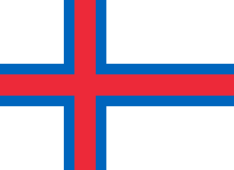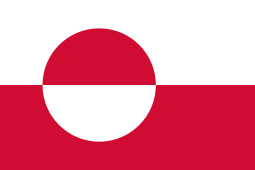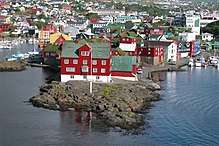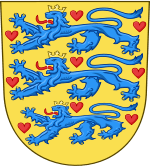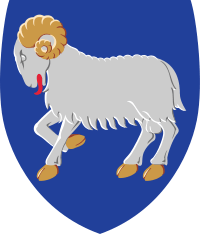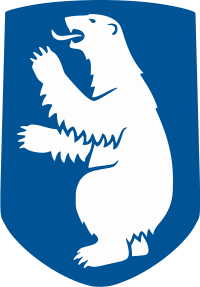Danish Realm
The Danish Realm or the Realm of Denmark (Danish: Danmarks Rige, Faroese: Danmarkar Ríki,[8] Greenlandic: Danmarkip Naalagaaffia[9]) consists of Denmark proper[lower-alpha 2] and its two autonomous territories: the Faroe Islands and Greenland. Together they are organized in the sovereign state the Kingdom of Denmark (Danish: Kongeriget Danmark[11]). The relationship between the three parts of the Kingdom is commonly known as The unity of the Realm (Danish: Rigsfællesskabet,[12] Faroese: ríkisfelagsskapurin, Greenlandic: naalagaaffeqatigiit).
| Rigsfællesskabet (Danish) Ríkisfelagsskapurin (Faroese) Naalagaaffeqatigiit (Greenlandic) | |
| Parts | |
| Denmark Faroe Islands Greenland | |
.svg.png) Territory within the Danish Realm | |
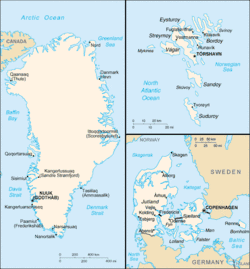 Clockwise from top left (sizes not to scale): Maps of Greenland, the Faroe Islands, and Denmark. | |
| Official languages | |
|---|---|
| Danish |
| Faroese and Danish[1] |
| Greenlandic and Danish[2] |
| Constitutional status | Unitary state |
| Government | |
| Margrethe II of Denmark | |
| Mette Frederiksen | |
| Bárður á Steig Nielsen |
| Kim Kielsen |
| Legislature | |
| Folketinget | |
| Løgting | |
| Inatsisartut | |
| Establishment | |
| 24 March 1948[3] |
| 1 May 1979[4] |
| 29 July 2005[5][6] |
| 21 June 2009 |
| Area | |
| 42,926 km2 (16,573.8 sq mi) | |
| 1,396 km2 (538.999 sq mi) | |
| 2,166,086 km2 (836,330 sq mi) | |
| Population | |
| 5,822,763 (in 2020) | |
| 52,154 (in 2020) | |
| 56,081 (in 2020) | |
| Currency | Danish krone[lower-alpha 1] (DKK) |
| Time zones | |
| UTC+1 (CET) |
| UTC (WET) |
| UTC-4 to 0 (AST, WGT, EGT, GMT) |
| Summer (DST) | |
| UTC+2 (CEST) |
| UTC+1 (WEST) |
| UTC-3 to 0 (ADT, WGST, EGST, GMT) |
| Calling codes[7] | |
| +45 | |
| +298 | |
| +299 | |
| Internet TLDs | |
| .dk |
| .fo |
| .gl |
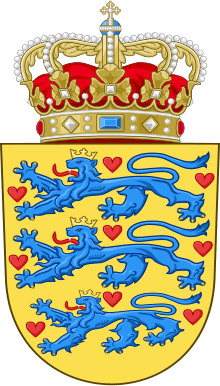 |
|---|
| This article is part of a series on the politics and government of Denmark |
|
|
|
The unity of the Realm |
|
|
Legislature
|
|
|
|
|
Related topics |
The Realm of Denmark is not a federation; it is a collection of a state and territories united under its monarch. The Kingdom of Denmark is a unitary sovereign state. It has one Artic territorial claim (Hans Island). Constitutionally, the Kingdom of Denmark encompass the realm, but the Faroe Islands and Greenland have an extended degree of autonomy to govern their relations.
The Faroe Islands and Greenland have been under the Crown of Denmark since 1397 (de facto) when the Kalmar Union was ratified, and part of the Danish Realm since 1814 (de jure). However, due to their separate historical and cultural identities, these parts of the Realm now have an extensive degree of self-government and have assumed legislative and administrative responsibility in a substantial number of fields.[13]
Legal matters in the Realm are subject to the Constitution of the Realm of Denmark.[14] It stipulates that it applies for all parts of the Kingdom of Denmark and that legislative, executive and judicial powers are the responsibility of the Parliament of the Kingdom of Denmark (Folketing), the Government of Denmark and the Supreme Court of Denmark. The Faroe Islands received home rule in 1948 and Greenland did so in 1979. In 2005, the Faroes received a self-government arrangement, and in 2009 Greenland received "self rule", thus leaving the government of Denmark with little influence over the matters of internal affairs, that are devolved to the local governments of Greenland and the Faroe Islands.
Name
The sovereign state which holds sovereignty over the Danish Realm is named "Kingdom of Denmark" (Danish: Kongeriget Danmark).[15][16] The constitution of the Kingdom of Denmark refers to the state's territory as Danmarks Rige, which means "Danish Realm".[17]
The Danish term rigsfællesskabet, typically translated "The unity of the Realm",[12] alternatively "commonwealth of the Realm",[18][19] refers to the constitutional status of the relationship between Denmark, the Faroe Islands, and Greenland.[20] The name was used by Danish and Greenlandic authorities in the negotiations for home rule introduced in 1979, and have become popular since the beginning of the 1990s. The acts establishing the 1948 Faroese home rule and the 1979 Greenlandic home rule use the term rigsenheden instead. Jurist Frederik Harhoff argued in 1993 that rigsenheden should be replaced with rigsfællesskabet, as the former implies a common identity, while the latter implied a community of different identities.[20] The use of the expression Rigsfællesskabet though can be traced back to at least 1908.[21]
Population and area
.svg.png)
Denmark's population is by far the largest of the three; there lives 5.8 million people in Denmark, and about 52.000 and 56.000 in the Faroe Island and Greenland, respectively.[22][23][24] In comparison, there are ten cities in Denmark with a population above 50.000 people.[25] Denmark is populated by the Danes, the Faroe Island by the Faroese, and Greenland by the Greenlandic Inuit. In both the Faroe Islands and Greenland, Danes make up 7.6% of the population, as of 2018.[26][27][28] As of 2020, there are about 11.000 Faeroese-born and 17.000 Greenlandic-born people living in Denmark.[29][30]
With respect to area, Greenland is by far the largest, and make up 98% of the realm.[31] The entire kingdom has an area of 2.2 million square kilometers, and is according to The World Factbook the twelfth largest country in the world, the same rank held by Greenland alone. Denmark alone has an area of about 43.000 km2, and is no. 133 on that list.[32] Denmark is situated in Northern Europe and is flat and arable, the Faroe Islands in the Northern Atlantic and is rugged with cliffs along the coast, while Greenland is in the North Atlantic and Arctic, and is 79% covered in ice.[26][27][28] Greenland is the most sparsely populated territory in the world, according to the World Bank.[33]
| Part | Area[31] | Population (2020)[22][23][24] | |||
|---|---|---|---|---|---|
| km2 | % | Population | % | Density | |
| 42,926 | 1.94% | 5,822,763 | 98.17% | 135.65 per km2 | |
| 1,396 | 0.06% | 52,154 | 0.88% | 37.36 per km2 | |
| 2,166,086 | 98.00% | 56,081 | 0.95% | 0.03 per km2 | |
| Entire realm | 2,210,408 | 100.00% | 5,930,998 | 100.00% | 2.683 per km2 |
Historical background
The Faroe Islands were settled by Norwegian vikings in the 9th century, displacing Irish monks already there.[34] Iceland was settled in the 9th century by Norsemen, and was a free state until 1262/1264, when it came under Norwegian taxation.[35] Greenland, already populated by the indigenous Greenlandic Inuit, was settled by Norwegians in the 10'th century, among those Erik the Red.[36] The connection to Greenland was lost in the 15th century, but Denmark–Norway again established connections in 1721 though the missionary Hans Egede.[36]
In 1814, Denmark ceded Norway to Sweden under the Treaty of Kiel, but kept control of the Faroe Islands, Greenland, and Iceland.[37] The colonies on Greenland were situated on the west coast, and as a condition for the sale of the Danish West Indies to the United States in 1917, the U.S. recognized Danish sovereignty over the whole island, and most countries followed suit. One exception was Norway who in 1931 occupied parts of East Greenland, but abandoned their claim in 1933, when it lost the case at the Permanent Court of International Justice.[36]
In Iceland there were a growing nationalism in the 19th century, and Iceland was in 1874 given its own constitution and increased autonomy, but still with the executive power in Danish hands. Iceland was granted home rule in 1904, and, by the Danish–Icelandic Act of Union, full independence in 1918. The act established a personal union between Denmark and the newly created Kingdom of Iceland, with Denmark handling coastal protection and foreign affairs. In 1944, Iceland abolished the personal union and adopted a new constitution that established the current republic, after a referendum on the subject. This happened during World War II, where Denmark and Iceland were cut off from each other, as Denmark was occupied by Germany, and Iceland by the United Kingdom.[35]
The Faroe Islands were made a Danish county in 1816, and with the constitution of 1849, it gained representation in the Rigsdag.[34] During World War II, the Faroe Islands were occupied by the United Kingdom and they largely administrated themselves.[34] After the war, it was clear that the old system could not be reinstated.[38][34] In an independence referendum in 1946, 50.7% of the Faeroese voted for independence,[38] but the result was rejected by the Danish government.[34] Instead, after negotiations between the Faroe Islands and Denmark, the Faroe Islands were granted "home rule" in 1948.[34][38]
Greenland was administrated like a colony until a constitutional reform in 1953, where it was incorporated into Denmark as a county and given representation in the Folketing.[39] When Denmark joined the European Communities (EC) in 1972, Greenland followed, despite 70% of the Greenlandic voters voted against it in the referendum. As a home rule agreement would allow them to leave again (the Faroe Island did not join the EC), this was an important factor in the increasing support for home rule. Another factor was a wish to make Greenland more Greenlandic. They were given home rule in 1979 and left the EC in 1985. Under the home rule agreement, Greenland gradually took over more responsibility from the Danish state. In 2009, the home rule was replaced with "self rule", granting greater autonomy.[36]
Constitutional status
The Danish constitution also applies in the Faroe Island and Greenland, as section one states that it "shall apply to all parts of the Kingdom of Denmark".[16] The sovereignty of the Faroe Island and Greenland is held by the Danish state. The Kingdom of Denmark is a unitary state, with the Folketing being its unicameral legislature. The Faroe Island and Greenland each elect two members to the parliament; the remaining 175 members are elected in Denmark.[16]
Home rule and self rule
The Folketing have by law given the Faroe Island and Greenland extensive autonomy; the Faroe Island was given "home rule" in 1948, and Greenland was too in 1979. Greenland's home rule was in 2009 replaced by "self rule".[34][36] There is an ongoing legal debate about what constitutional weight these arrangements have. In general, there are two conflicting views: (a) the laws delegate power from the Folketing and can be revoked unilaterally by it, and (b) the laws have special status so changes require the consent of the Faeroese Løgting or the Greenlandic Inatsisartut, respectively.[38][40]
Proponent of the first interpretation include Alf Ross,[38] Poul Meyer,[38] and Jens Peter Christensen.[41] Ross, the chief architect of the Faeroese home rule, compared it to an extended version of the autonomy of municipalities.[38] Meyer wrote in 1947, prior to the Faeroese home rule, that if power was delegated as extensive in other parts of the country, it would probably breach section 2 of the 1915 constitution, suggesting it did not do that here due to the Faroe Islands' separate history.[38] Similarly, Christensen, a Supreme Court judge, said that due to the special circumstances, the scope of delegation need not be strictly defined.[41]
Proponents of the second interpretation include Edward Mitens,[38] Max Sørensen[40] and Frederik Harhoff.[38] Mitens, a Faeroese jurist and politician, argued that the Faeroese home rule had been approved by both the Løgting and the Rigsdag, so it was an agreement between two parties, in particular because the approval by the Løgting happened according to special rules put in place in 1940 with the consent of the Danish representative there, during the occupation by the United Kingdom.[38] Sørensen said the intention with the Faeroese home rule was that it should not be unilaterally changed, as stated in the preamble, so it had that effect.[40] Harhoff, in his 1993 Doctorate dissertation, considered the home rule acts of the Faroe Islands and Greenland to be somewhere in between the constitution and a usual act by the Folketing, as it had been treated as such.[38]
Greenlandic independence
The Greenlandic self rule act of 2009 gives Greenland a way to achieve independence. First, the Greenlandic people must make the decision, after which there should be negotiations between the Greenlandic government (Naalakkersuisut) and the Danish government about how to practically implement it. The agreement reached needs to be ratified by Inatsisartut, and approved in a referendum in Greenland. It also needs consent from the Folketing, in accordance with section 19 of the Danish constitution.[42] That section states that any changes to the Kingdom's territory needs to be approved by the Folketing.[16] Greenlandic independence does not require a constitutional change; instead, should Greenland become independent, the rules in the constitution regarding Greenland becomes void.[43]
With regards to international law, Denmark signed the Indigenous and Tribal Peoples Convention in 1996 and acknowledged the Greenlandic Inuit as an indigenous people.[43][40] In the 2009 self rule act, Denmark recognized the Greenlandic people as a "people" within the context of international law, and their inherent right to self-determination.[36]
Devolved powers
The Kingdom of Denmark constitutes an unified sovereign state, with equal status between its constituent parts.[44] Devolution differs from federalism in that the devolved powers of the subnational authority ultimately reside in central government, thus the state remains de jure unitary.
The Self-Government Arrangements devolves political competence and responsibility from the Danish political authorities to the Faroese and the Greenlandic political authorities. The Faroese and Greenlandic authorities administer the tasks taken over from the state, enact legislation in these specific fields and have the economic responsibility for solving these tasks. The Danish government provides an annual grant to the Faroese and the Greenlandic authorities to cover the costs of these devolved areas.[13]
The 1948 "Home Rule Act of the Faroe Islands" sets out the terms of Faroese home rule. The Act states, "...the Faroe Islands shall constitute a self-governing community within the State of Denmark."[3] It establishes the home government of the Faroe Islands (Landsstýrið) and the Faroese parliament, the Løgting. More significantly, the Act specifies the powers devolved from the Government of Denmark, including: local government and municipal affairs; taxation, at a local and territorial level; public services, including police and town planning; welfare services, such as housing; primary and secondary education; Archives, libraries, museums; agriculture and fishing; entertainment; among other areas.[3] The Faroe Islands were previously administered as a Danish county (amt); the Home Rule Act abolished the post of Amtmand (County Governor) and replaced it with the role of Rigsombudsmand (High Commissioner of the Danish government).[3] These powers were expanded in a 2005 Act, which named the Faroese home government as an "equal partner" with the Danish government.[45]
The 1978 "Greenland Home Rule Act" devolves powers in much the same way as the Faroese Home Rule Act. It sets out a home rule government and Greenlandic parliament. Specific areas of governance specified in the act include: Organization of local government; Fishing and agriculture; Welfare system; protection of the environment; other areas affecting Greenlanders directly, etc.[4]
On 21 June 2009, Greenland assumed self-determination with responsibility for self-government of judicial affairs, policing, natural resources, immigration and border controls. Also, Greenlanders were recognized as a separate people under international law.[46] Greenland is now described as having "self rule", with its home government exercising a wider range of powers.
There are a number of matters that can not be acquired by the territories; Constitutional affairs, foreign policy, defence, the Supreme Court, citizenship, and monetary policy. Additionally, the Faroese and Greenlandic parliaments are subordinate to the Danish parliament, where the two territories are represented by two seats each (from a total of 179 seats).
The Faroe Islands have gradually taken control of more and more areas of responsibility according to their Home Rule Act from 1948.[47] The Faroese/Danish act of 2005 states: "This law is based on an agreement between the Governments of the Faroe Islands and Denmark as equal partners."[48]
Foreign affairs
Previously, most foreign relations were undertaken exclusively by the Government of Denmark on behalf of the entire realm, but more recently the Faroe Islands and Greenland have increased their role in foreign policy. Representatives for both have joined Danish delegations in discussions on some international matters, such as fishing rights. Greenlandic representatives were included in the process of a new treaty between Denmark and the US regarding the Thule Air Base in northwest Greenland.
The Kingdom of Denmark as a whole is a member of the United Nations, NATO, the OECD and the World Trade Organization. The Faroe Islands and Greenland are associated members of the Nordic Council in their own right as part of Denmark's membership. Although the Kingdom of Denmark is a member of the European Union, both areas have special dispensation and remain outside the EU. Greenland joined the EU as part of Denmark in 1973, but opted to leave in 1985 after Greenlandic home rule was introduced in 1979.
The "Home Rule Act of the Faroe Islands" specifies that a 'Faroese' shall be understood to mean a person who is a "national of Denmark and a resident of the Faroe Islands".[3] The Government of Denmark issues special passports for its citizens living in the Faroe Islands and Greenland with the right to choose a regular Danish passport as well. The Faroese Home Rule Act states that, in Faroese passports, Føroyingur (Faroese) and Føroyar (Faroe Islands) shall be inserted after the words Dansk (Danish) and Danmark (Denmark).[3]
Not devolved
The provisions for home rule are limited to internal matters only. Neither Greenland nor the Faroe Islands can write laws which concern the relationship with other states, nor laws that apply to the entire Realm; furthermore, the Supreme Court (Danish: Højesteret) in Copenhagen is the final legal instance, and legal matters from Greenland and the Faroe Islands must be prepared for that court, like any Danish matter. Danish currency is also legal tender in Greenland and the Faroes, and Denmark is responsible for military defense.[49] Further, for rare treatments and certain surgery, Greenlanders and Faroese are often directed to Copenhagen's National Hospital (Rigshospitalet).
Terminology
- Hjemmestyre
- Meaning "home rule", it indicates an autonomous administration (present in both in Greenland and the Faroe Islands) that has power over many internal affairs. In this arrangement, the Danish government deals with external matters such as defence and foreign affairs. Greenland and the Faroe Islands maintain their own elected assemblies and administrations, headed by a premier who appoints a cabinet. This is synonymous with "self-governing".
- Selvstyre
- Following a referendum on 25 November 2008 (the 30th anniversary of the establishment of home rule in Greenland), the relationship between the Danish and Greenlandic governments changed, with Greenland gaining greater autonomy. Further powers were granted to the Greenlandic government on 21 June 2009, including control of the police force, coastguard, and courts. Additionally, Greenland now receives fewer Danish subsidies, becoming more self-sufficient.[50] As a result of these changes, Greenland was then said to have self rule with minimal support from Denmark, as opposed to "home rule".
- Rigsombudsmand
- High Commissioners represent the interests of Denmark in the Faroe Islands and Greenland. There is one Danish High Commissioner in each territory. He or she can attend the meetings at the Løgting in the Faroes and at the Inatsisartut in Greenland, but can't vote.
- Folketingsmedlemmer fra Færøerne og Grønland
- Members of the Folketing from the Faroe Islands and Greenland: Greenland and the Faroe Islands and their self-rule administrations take part in consultations on policies and decisions affecting their region, including negotiations with the devolved legislatures and the Danish parliament (folketing). Greenland and the Faroe Islands have two members of the Danish folketing each, with full voting privileges.
See also
- List of Danish High Commissioners in Greenland
- List of Danish High Commissioners in the Faroe Islands
- Kingdom of Iceland
- Constitution of Denmark
- Norwegian Realm
- Faroese independence
- Greenlandic independence
- Icelandic independence movement
- Norwegian independence movement
Literature
- Adriansen, Inge (2003): Nationale symboler i Det Danske Rige 1830-2000, Vol I (Fra fyrstestat til nationalstater), Museum Tusculanum Press, University of Copenhagen. (in Danish)
- Adriansen, Inge (2003): Nationale symboler i Det Danske Rige 1830-2000, Vol II (Fra undersåtter til nation), Museum Tusculanum Press, University of Copenhagen. (in Danish)
Notes
- In the Faroe Islands the currency has a separate design and is known as the Faroese króna, but is not a separate currency.
- The Kingdom of Denmark's territory in continental Europe is referred to as "Denmark proper" (Danish: egentlig Danmark), "metropolitan Denmark",[10] or simply Denmark. In this article, usage of "Denmark" excludes Greenland and the Faroe Islands.
References
- Magnussen, Kristin (1 January 2009). "Sprog i fokus: Færøsk". Sprog i Norden (in Danish). 40(1): 251–258.
- "Inatsisartutlov nr. 7 af 19. maj 2010 om sprogpolitik" (in Danish). Formandens Departement. Retrieved 6 May 2020.
- "Home Rule Act of the Faroe Islands". Prime Minister's Office. 23 March 1948. Retrieved 19 May 2014.
- "The Greenland Home Rule Act". Prime Minister's Office. 29 November 1978. Retrieved 20 May 2014.
- "Lov om de færøske myndigheders overtagelse af sager og sagsområder" (in Danish). Retsinformation. 24 June 2005. Retrieved 23 September 2015.
- "Den færøske hjemmestyreordning" (in Danish). Statsministeriet. Retrieved 23 September 2015.
- International Telecommunication Union (1 November 2011). "List of ITU-T Recommendation E.164 assigned country codes" (PDF). Archived (PDF) from the original on 31 January 2012.
- "Stjórnarrættarliga støða Føroya" (PDF) (in Faroese). LØGMANSSKRIVSTOVAN. Retrieved 30 May 2020.
- "Danmarkip naalagaaffiata inatsisai tunngaviusut" (in Kalaallisut). High Commission of Denmark in Greenland. Retrieved 30 May 2020.
- Administrative divisions – Denmark The World Factbook. Access date: 14 April 2012
- Udenrigsministeriet – Ministry of Foreign Affairs: "Rigsfællesskabet"
- "The unity of the Realm". The Prime Minister's Office. Retrieved 25 July 2020.
- "Greenland and the Faroe Islands". Denmark.dk. Ministry of Foreign Affairs of Denmark. Archived from the original on 21 May 2014. Retrieved 19 May 2014.
- See "Danmarks Riges Grundlov" (§ 1).
- Nielsen, Bue (16 April 2017). "Danmark". Den Store Danske (in Danish). Gyldendal. Retrieved 4 April 2020.
- My Constitutional Act – My Constitutional Act with explanations (12. ed.). Folketinget. 2014. ISBN 978-87-7982-168-2.
- Min grundlov – Grundloven med forklaringer (in Danish) (14. ed.). Folketinget. 2017. ISBN 87-7982-172-3.
- "Arctic: Research". Danish Meteorological Institute. Retrieved 4 May 2020.
- "The right to vote in Greenland". The Nordic Council and the Nordic Council of Ministers. Retrieved 4 May 2020.
- Adriansen, Inge (2003). Nationale symboler i Det Danske Rige 1830-2000. Etnologiske Studier (in Danish). 1. Museum Tusculanum Press. p. 435. ISBN 978-87-7289-794-3. ISSN 1398-8980.
- Knud Berlin. "Island. Slutningsreplik til Dr. Berlin". Dannebrog (2 Nov. 1908). Retrieved 24 July 2020.CS1 maint: multiple names: authors list (link)
- "Population in Denmark". Statistics Denmark. Retrieved 2 May 2020.
- "Population". Statistics Faroe Islands. Retrieved 2 May 2020.
- "Population 2020". Statistics Greenland. Retrieved 2 May 2020.
- Statistisk Årbog 2017 (in Danish). Statistics Denmark. 2017. p. 23. ISBN 978-87-501-2262-3.
- "Europe :: Denmark". The World Factbook. CIA. Retrieved 2 May 2020.
- "Europa :: Faroe Islands". The World Factbook. CIA. Retrieved 2 May 2020.
- "North America :: Greenland". The World Factbook. CIA. Retrieved 2 May 2020.
- "BEF5F: People born in Faroe Islands and living in Denmark 1. January by sex, age and parents place of birth". StatBank Denmark. Statistics Denmark. Retrieved 2 May 2020.
- "BEF5G: People born in Greenland and living in Denmark 1. January by sex, age and parents place of birth". StatBank Denmark. Statistics Denmark. Retrieved 2 May 2020.
- "Nøgletal for Danmark, Færøerne og Grønland - Statistisk Årbog 2017" (PDF) (in Danish). Statistics Denmark. Retrieved 2 May 2020.
- "Country Comparison :: Area". The World Factbook. The list include Antarctica, which is not a country. CIA. Retrieved 2 May 2020.CS1 maint: others (link)
- "Population density (people per sq. km of land area)". The World Bank Group. Retrieved 2 May 2020.
- Wåhlin, Vagn (16 August 2011). "Færøernes historie". danmarkshistorien.dk (in Danish). Aarhus University. Retrieved 28 April 2020.
- S. Arnórsdóttir, Agnes (3 September 2018). "Islands historie". danmarkshistorien.dk (in Danish). Aarhus Universitet. Retrieved 28 April 2020.
- Kjær Sørensen, Axel (26 August 2019). "Grønlands historie". danmarkshistorien.dk (in Danish). Aarhus University. Retrieved 28 April 2020.
- Bregnsbo, Michael (27 January 2014). "Freden i Kiel 14. januar 1814". danmarkshistorien.dk (in Danish). Aarhus University. Retrieved 28 April 2020.
- Andrias Sølvará, Hans (2003). "Færøernes statsretlige stilling i historisk belysning– mellem selvstyre og selvbestemmelse" (PDF). Faroese Law Review (in Danish). 3: 146–181.
- Mølholm Olesen, Simon (16 March 2017). "Grønlands afkolonisering, 1945-1954". danmarkshistorien.dk (in Danish). Aarhus University. Retrieved 28 April 2020.
- Hertig, Mikael (March 2018). "Indkald tvistnævnet: Er Selvstyreloven forfatningsstridig?". Tidsskriftet Grønland (in Danish). Det Grønlandske Selskab. 1: 17–30.
- Hansen Jensen, Michael; Albæk Jensen, Jørgen; Peter Christensen, Jens (2016). Dansk Statsret (in Danish) (2 ed.). Djøf Forlag. pp. 145, 153. ISBN 9788757434750.
- "The Greenland Self-Government Arrangement". The Prime Minister's Office. Retrieved 6 May 2020.
- Sørensen, Max; Danielsen, Jens Hartig (2011). "Grønlands Selvstyre og Danmarks Riges Grundlov". Juristen (in Danish). Djøf Forlag. 2011(1): 9–18.
- Denmark Regulations Handbook. Int'l Business Publications. 3 March 2008. p. 19. ISBN 9781433069710. Retrieved 1 September 2015.
"...a relationship known in Danish as Rigsfællesskabet (Commonwealth of the Realm)
- retsinformation.dk Lov om de færøske myndigheders overtagelse af sager og sagsområder(in Danish) Denne lov bygger på en overenskomst mellem Færøernes landsstyre og den danske regering som ligeværdige parter.
- Description of the Greenlandic Self-Government Act on the webpage of the Ministry of State of Denmark"The Self-Government Act provides for the Self-Government authorities to assume a number of new fields of responsibility, such as administration of justice, including the establishment of courts of law; the prison and probation service; the police; the field relating to company law, accounting and auditing; mineral resource activities; aviation; law of legal capacity, family law and succession law; aliens and border controls; the working environment; as well as financial regulation and supervision, cf. Schedule I and II in the Annex to the Self-Government Act."
- "Logting.elektron.fo".
- "Retsinformation.dk, Lov om de færøske myndigheders overtagelse af sager og sagsområder".
- Danish Department of Justice PDF (2005), issues 3.2, 3.3 and 3.4 to 3.4.5 at [www.logting.fo/files/casestate/4609/092.04%20Bilag%201.pdf]
- Greenland votes for more autonomy BBC News, 26 November 2008
Sources
- The Danish Constitution for the Danish Realm: Danmarks Riges Grundlov, no. 169 of 5 June 1953. (in Danish)
External links
- The unity of the Realm; the status the Faroe Islands and Greenland (Prime Minister's Office)
- Tourism portal at VisitDenmark.
- Tourism portal at VisitGreenland.
- Tourism portal at VisitFaroeIslands.
- Government
Denmark:
- Stm.dk – official Danish government website
- um.dk – official Ministry of Foreign Affairs of Denmark website
- Statistics Denmark (DST) – Key figures from the Danish bureau of statistics
- "Regions of Denmark". Statoids.
Greenland:
- Naalakkersuisut.gl – official Greenlandic government website
- Naalakkersuisut.gl – official Ministry of Foreign Relations of Greenland website
- Statistics Greenland (GST) – Key figures from the Greenlandic bureau of statistics
- "Administrative divisions of Greenland". Statoids.
Faroe Islands:
- Government.fo – official Faroese government website
- Government.fo – official Ministry of Foreign Relations of the Faroe Islands website
- Statistics Faroe Islands (FST) – Key figures from the Faroese bureau of statistics
- "Regions of the Faroe Islands". Statoids.
- News and media

